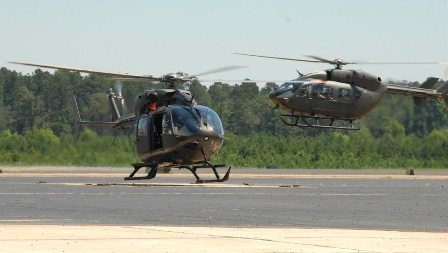The Army National Guard is preparing to receive the first Light Utility Helicopter equipped with a new, state-of-the-art mission equipment package.
The new mission equipment package, or MEP, aboard the UH-72A Lakota Light Utility Helicopter includes an electro-optical/infrared sensor, enhanced cockpit screens, high power illumination system, analog-digital data downlink capability and GPS-enhanced moving map displays.
A UH-72A “security and support” MEP was on display at the Army Aviation Association of America’s Annual Exposition, April 17-20, 2011, in Nashville, Tenn. The package will complete certification testing in May, and be followed by training before being delivered to the National Guard.
The security and support, or S&S, equipped Light Utility Helicopter aircraft will be ready to conduct humanitarian and disaster relief efforts as well as other key missions such as border patrol and counter-drug enforcement.
One system aboard the S&S aircraft is a GPS-guided navigation system with moving maps and street addressees — something useful when conducting domestic missions.
“We put a navigation system in which allows us to put in a street address and it will navigate pilots to that precise location,” said Col. Neil Thurgood, program manager, utility helicopters. “We learned during Hurricane Katrina that the fire department, for example, will say ‘hey, go to the corner of 5th and Main.’ As Army aviators we don’t necessarily know where that is.”
Gregory Barth, LUH project management office avionics lead, said the system guides aviators to those locations to help them facilitate rescues, for instance, or to conduct counter-drug operations.
“We have aeronautical charts and you can zoom through those and get down into street level maps,” Barth said. “If you are doing a Medevac (medical evacuation) mission for example, where you are given a street address, we can enter that street address into our database and command that to our flight management system which will direct the pilots to that exact location.”
“The pilots will get all the visual cues on how to get there,” he explained. “We can also use it for aircraft which do counter-drug missions. The moving map is a great addition to this aircraft as it gives pilots a lot more situational awareness.”
The new Lakota S&S package also comes equipped with a MX15i EO/IR sensor and Data Downlink enabling pilots to view and share key data in real time with personnel on the ground, Barth explained.
“The data downlink allows units on the ground to see what the aircraft is seeing out of its sensor. It is a dual frequency band that is conducive for both imagery and video,” he said.
The aircraft also has a new RT5000 radio system able to transmit simultaneously on multiple bands.
“What’s unique about this is not only can we communicate on all the civil band radios such as police, fire department, hospitals and first responders, but we can also communicate on the military frequencies,” said Thurgood.
The Army National Guard plans to buy at least 100 UH-72A S&S package aircraft; 17 of them will be retrofitted and 83 of them will roll new off the production line, Barth explained.
The UH-72A is built by EADS North America at their American Eurocopter production facility in Columbus, Miss.
“This is important to us,” Thurgood said. “This is jobs, technical skills and advanced avionics coming to the United States in support of our military and our industrial base in support of our mission.”
The addition of UH-72A’s into the Army inventory has freed up at least 23 Black Hawk helicopters for military service oversees, Thurgood said.
Also, Thurgood praised the Army for sticking to its requirements for the Lakota aircraft and praised EADS North America for delivering aircraft on cost and schedule. The Lakota helicopter is built mostly with commercial-off-the-shelf technologies.











